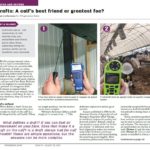December 2019 Newsletter
Click here to view as a pdf: 2019 December Newsletter
Shop online or call 1-888-376-6777 to place an order. ![]()
Click here to view as a pdf: 2019 December Newsletter
Click here to view as a pdf: Windy Hill Kennel
By Ben Hickerson, B.S.
Nestled in the hills of Holmes County, Ohio, you will find Windy Hill Kennel, owned and operated by Robert Beachy. Robert’s interest in dogs and dog breeding started as a young boy when his father owned a few dogs as a hobby breeder. In the spring of 2000, Robert expanded on his interest and started a new endeavor with a small kennel consisting of Boston Terriers, Shiba’s, and English Bulldogs. After 12 years in the dog breeding industry, Robert decided to take his facility to the next level and make it the best it could be.
Click here to view as a pdf: Improving Butterfat Using Components To Drive Profitability
With the economic challenges facing the dairy industry today, farmers are looking for any and every way to increase profit and maintain sustainability. We are currently in a market where the volume of milk is exceeding the demand. In this situation, striving to produce more milk can be expensive and often have a minimal return. An alternative to increased volume is increasing the nutrient quality of the milk through higher butterfat content. This can make a large impact on a farm’s bottom line. In July of 2019, the average national price paid for butterfat was $2.69 per pound.1 A cow producing 75 pounds of milk could increase income by $0.30 per day if butterfat content was raised from 3.6 to 3.9%. Along with the economic impact, higher components are also a sign of good rumen health indicating efficient digestion. Increasing butterfat is not always easy, but there are strategies that can help improve milk components to drive a farm’s profitability.
Click here to view as a pdf: Crystal Creeks Beef Mineral Has A New Name ROI
By Teresa Marker, B.S.
Crystal Creek® is launching a new name for our beef mineral, now known as ROI® Beef Mineral. R.O.I. is an acronym commonly used in the investing community that stands for Return on Investment. The definition of return on investment (R.O.I.) is a ratio between net profit and the cost of investment. When looking at an input, like a mineral supplement, a producer should always evaluate the cost of the input against the return it will generate. To justify its use, any input will need to show a positive return; whether the effect is on animal health, net profit, or both. Before understanding the economics of mineral supplementation for beef cows, we must first understand the important roles that minerals play in the body.
Click here to view as a pdf: The Myth Of All In One Small Ruminant Feed And Mineral
Sheep and goats are a completely different species. They have a different number of chromosomes; sheep have 54 and goats have 60. They have different feeding preferences; sheep prefer to graze on pasture, while goats will browse and eat more twigs and brush. Another significant difference is their nutritional requirements. So, if these small ruminants are so different why does the feed industry promote an all-in-one sheep and goat mineral and all-stock feed?
Dr. Ryan Leiterman’s recent article “Drafts: A Calf’s Best Friend or Greatest Foe” has been published in the Progressive Dairy Magazine.  This article addresses why drafts are traditionally thought of as a negative experience for calves and how they can be used to one’s advantage in certain situations. Read more here to learn what the pros and cons of drafts can be in calf barn ventilation.
This article addresses why drafts are traditionally thought of as a negative experience for calves and how they can be used to one’s advantage in certain situations. Read more here to learn what the pros and cons of drafts can be in calf barn ventilation.
Click here to view as a pdf: A calf’s best friend or greatest foe
By Dr. Ryan Leiterman
Drafts and pre-weaned calves – rarely is a topic so misunderstood. Many calf raisers are uncomfortable with the topic of drafts on calves, regardless of the outside temperature. Most people believe drafts are to be avoided at all costs. I once heard of a veterinarian who would spark a lighter in a calf pen and if the flame flickered, even the slightest bit, would declare the presence of a dangerous draft. Contrary to popular belief, however, drafts on pre-weaned calves are not always a bad thing. In fact, in certain situations, they can even be beneficial.
Click here to view as a pdf: 2019 August Newsletter
Click here to view as a pdf: A New Generation Of Mycotoxin Technology

By Dan Leiterman
In my April 2016 newsletter article “Managing Mycotoxins In Feedstuffs: Mycotoxin Binder Strategies”, I explained the significant negative effects mycotoxins have on livestock health and production. That article pointed out the previous challenges of inaccurate lab analysis of mycotoxins, how to interpret a lab analysis to determine a management plan for a given level of exposure and the subsequent limitations of strategies available at the time. This article can be found on our website under the “Articles” tab, under the sub-category of “Inoculant.”
Click here to view as a pdf: How To Determine The Value Of Whole Leaf Aloe Vera For Your Livestock
By Teresa Marker, B.S.
Stress is defined as a state of strain from adverse or demanding conditions. Livestock can be stressed by many different factors: weaning, pen movement, dehorning, vaccinating, shipping, lactation, weather, flies, etc. Some of these stressors can be reduced by good management, but not all stressors can be eliminated. The immune system of an animal has the ability to resist infection or disease. However, when animals are stressed, they are more vulnerable to disease due to decreased immune function.
Click here to view as a pdf: Heat Stress In Poultry
By Stephanie Hutsko, PhD
Simply put, heat stress occurs when a bird’s core temperature is higher than its thermoneutral zone (Figure 1). A thermoneutral zone is a temperature range in which an animal does not use any additional energy to maintain its normal core body temperature. Heat stress is a result of a negative balance between the energy transfer from the bird’s body to its environment and the amount of heat energy produced by the bird. This imbalance can be caused by multiple factors such as ambient temperature, humidity, air movement, metabolism rate and thermal irradiation. Effects can range from mild distress to death.